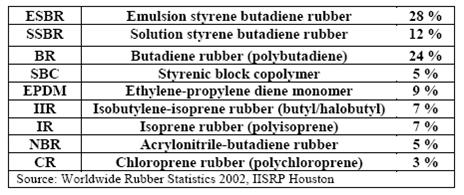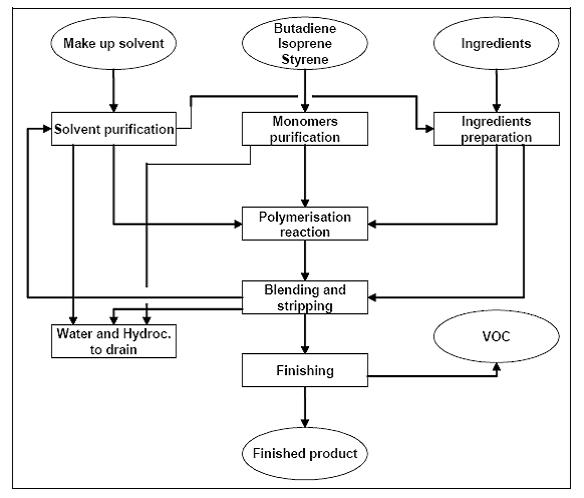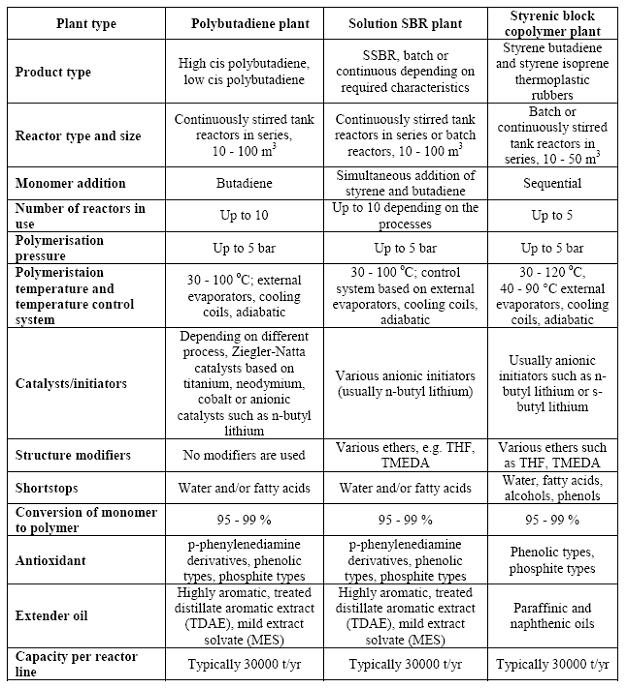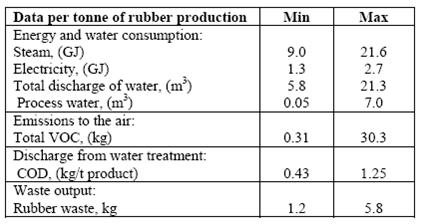Solution polymerized rubber containing butadiene
Back to Information about solution polymerized rubber containing butadiene
1 General description
Solution polymerised rubbers are usually homopolymers of butadiene or copolymers of styrene and butadiene. They can have a variety of behaviours and properties depending on the molecular structure. However, they are classed as one family because of one common feature of the polymerisation process, i.e. the monomers, catalyst and other ingredients are all dissolved in an organic solvent The family consists of, in order of market volume, polybutadiene (or butadiene rubber, BR), solution styrene butadiene rubber (SSBR) and styrenic block copolymers (SBC). A further subdivision may be made into those polymers that require vulcanisation (BR, SSBR) and those that do not (SBC). The latter are also known as thermoplastic rubbers as they have rubbery properties below a certain temperature when they soften and may be processed like thermoplastics. The following Table shows the production volume share of the major types of synthetic rubber, including ESBR.
Table 1: production volume share of the major types of synthetic rubber
These rubbers are used as follows:
- the principal use of BR is in the manufacture of car tyres, where it is used in blends with other synthetic rubbers to enhance abrasion resistance and to improve dynamic properties. It also finds use in conveyor belting, flooring, sheeting, hoses, seals and many other goods. BR has another large scale application outside the rubber manufacturing industry namely as an impact improver in thermoplastics such as polystyrene, to give the high impact types (HIPS), and ABS
- SSBR is used in tyre manufacture, particularly in the tread compound where it gives a good combination of grip, wear and low rolling resistance. It is also widely used in flooring, sheeting and shoe soles. Some types find application in the manufacture of adhesives
- SBC is a thermoplastic rubber and does not need to be vulcanised. It finds widespread use in footwear, adhesives, bitumen modification and sealants. Its thermoplastic nature allows it to be recycled. The modified bitumens have elastic properties and are used for roofing membranes and for roads.
Solution rubbers account for approximately 42 % of all synthetic rubber production. Worldwide about 5 million tonnes are produced yearly.
Solution polymerisation plants rely on the ready availability of butadiene and styrene and the reaction solvent, hence plants are often located as part of integrated refineries/chemical complexes, or as adjuncts to such complexes. A wide range of other chemicals such as catalysts, modifiers, shortstops, antioxidants and extender oils are also required. Two types of catalyst systems are used, the so-called Ziegler-Natta types and those based on alkyl lithium. Plants using the latter are often multipurpose producing polybutadiene, solution SBR and styrenic block copolymers in quantities depending on market demands. This makes it difficult to estimate the capacities for each type with any accuracy. For this reason, the plant capacities are expressed in terms of solution rubber in general.
- Polybutadiene (butadiene rubber, BR)
BR was first polymerised in Russia in 1910. It is the second largest volume synthetic rubber accounting for about 24 % of the total of all types. The consumption within the EU is approximately 340000 tonnes/year. BR is a raw material (a raw rubber) which has two main markets: the rubber goods industry and the plastics producers. The former blend it with other types of rubber and mix it with reinforcing fillers, oil and vulcanising chemicals to produce rubber compounds. The rubber compound is then shaped and vulcanised under heat and pressure to produce the finished rubber article. The latter incorporate a small amount (5 to 8 %) during their polymerisation processes to enhance the impact strength of the finished plastic. The most widely produced material is high impact polystyrene, HIPS. About 70 % of BR is used in the manufacture of car tyres, particularly in the sidewall where it improves flex and fatigue resistance and in the tread where it improves wear resistance, 10 % of BR is used to manufacture industrial goods such as conveyor belts, mill linings, flooring, hoses, seals, sheeting, footwear, golf balls and a large number of other rubber goods. About 20 % is used by the plastics industry. BR is a high performance product. It must be manufactured to the highest quality level because of its principal application in safety critical products. In other application areas, such as conveyor belts, the products are expected to perform well for many years under demanding conditions. In order to achieve the required performance and to give easy and consistent manufacturing processes, very tight specifications are applied by rubber goods manufacturers and the plastics industry.
- Solution styrene butadiene rubber (SSBR)
SSBR was first produced in the 1960s following the discovery of the alkyl lithium polymerisation catalyst. It is the third largest volume synthetic rubber accounting for about 12 % of the total of all types. Consumption within the EU is approximately 190000 tonnes/year. SSBR may be divided into two categories:
- a) random copolymers (80 %)
- The market for the random copolymers is completely dominated by the tyre industry (95 %). These types are usually extended with compatible oil. They are blended with other types of rubber, including natural rubber, and mixed with reinforcing fillers (carbon black and/or silica), oil and vulcanising chemicals to produce the tread compound where they improve wet grip and decrease rolling resistance thus improving in fuel consumption
- b) partial block types (20 %)
The partial block types are used in rubber flooring, carpet underlay, footwear and in many other applications. They also find widespread use in bitumen modification and in adhesives.
SSBR is a high performance product. It must be manufactured to the highest quality level because of its principal application in safety critical products. In order to achieve the required performance and to give easy and consistent manufacturing processes, very tight specifications are applied by rubber goods manufacturers and the other industries supplied.
- Styrenic block copolymers (SBC)
SBCs were developed in the US in the mid sixties. They are the largest volume thermoplastic elastomers, being polymers with rubberlike properties but able to be processed as thermoplastics. As a result of these properties, they present two advantages over conventional types: vulcanisation is unnecessary and the scrap can be reprocessed. SBCs account for about 5 % of the total synthetic rubber production. The consumption within the EU is approximately 280000 tonnes/year. SBCs are made using anionically catalysed polymerisation techniques. They are composed of well defined polystyrene and poly-diolefin blocks. Two basic types of configurations, linear and branched (or star) can be produced. The polystyrene and polydiene blocks are chemically incompatible and so a two phase system is formed. The hard polystyrene domains are linked to the rubbery polydiene phase and act as multifunctional cross-links. Below the glass transition temperature of polystyrene, SBCs act like vulcanised rubber whilst above it they act like thermoplastics. There are three major types of SBC:
- styrene butadiene styrene (SBS) block copolymers (80 %)
- styrene isoprene styrene (SIS) block copolymers (11 %)
- hydrogenated versions of SBS and SIS (9 %), being styrene ethylene butylenes styrene (SEBS) or styrene ethylene propylene styrene (SEPS).
Usually the compounds of SBCs are mixed continuously in a single or twin screw extruder. The SBCs are delivered in pellet or crumb form. The dry compound is premixed and then introduced into the extruder where the complete mixing and homogenisation of the ingredients takes place. SBCs are blended with thermoplastics such as polystyrene and inorganic fillers like clays and whiting. If required, the compounds may be plasticised with paraffinic or naphthenic oils. Some SBC types are supplied in the oil extended form. The hydrogenated types are ozone resistant and more resistant to the environment in general. SBCs are used to produce modified bitumen for roofing and roads (43 %), footwear (43 %), adhesives (11 %) and a wide variety of technical goods (3 %). Thermoplastic elastomers, in general, cannot compete with vulcanised rubber compounds where the highest level of physical properties are required. SBC also suffers from having a relatively low maximum operating temperature of about 70 C. Despite this, it has achieved considerable market penetration.
2 Flow diagram of solution polymerization
3 Technical parameters]]
Table 2: Technical parameters for typical solution plants
4 Emission and consumption levels
Table 3: Emission and consumption levels reported from 16 plants within the EU
Literature: BAT for Polymers, October 2006
Back to Information about solution polymerized rubber containing butadiene



